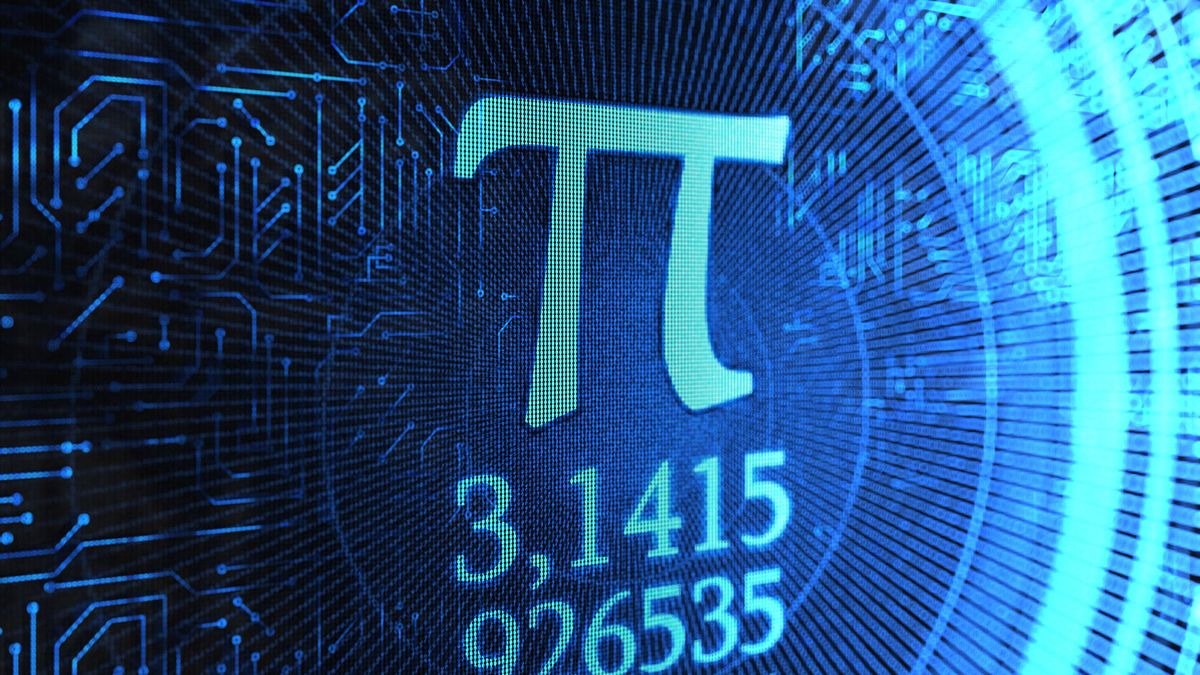
Pi has mesmerized mathematicians for 4,000 years. It’s the rarest mathematical constant, an unfailingly accurate ratio that’s also never-ending. Researchers have calculated the digits of pi to more than 22 trillion decimal places without any repetition (that’s called an “irrational number”).
But what is pi? The answer is simpler than you think.
What Is Pi?
Pi is a circle’s circumference divided by its diameter. (The diameter is twice the radius or double the length from any point on the circle to its center. The circumference is the distance around a circle.)
But what’s remarkable is that no matter the size of the circle you are measuring, that ratio of circumference to diameter will always equal 3.1415926535897, usually shortened to 3.14.
Divide the circumference of a tennis ball by its diameter and you get 3.14. Divide the circumference of the planet Mars by its diameter and you get 3.14. Divide the circumference of the known universe by its diameter (assuming it’s a perfect circle or sphere) — you get the point. As one mathematician put it, “Pi is part of the nature of the circle. If the ratio was different, it wouldn’t be a circle.”
This figure shows how the circumference of a circle with a diameter of 1.27 inches (32.35 millimeters) is equal to a linear distance of 4 inches (10.16 centimeters):
As you might imagine, 4.0 (the circumference) / 1.27 (the diameter) = 3.14.
A Storied Past: Tracing Pi’s History
Both the Babylonians and the Ancient Egyptians tried to estimate pi. Back in 1900 B.C.E., the Babylonians dabbled in the circle’s circumference and decided that pi equals approximately 3.125. Meanwhile, the Ancient Egyptians pitched in with their own rough numerical approximation: 3.1605.
Enter the Mathematicians
But it wasn’t until the Greek mathematician Archimedes and the Chinese mathematician Zu Chongzhi stepped onto the scene that pi’s estimation truly got refined to the most accurate approximation before calculus and supercomputers gave us the definitive answer [source: Exploratorium].
- Archimedes of ancient Greece: Particularly Archimedes, who lived between 287-212 B.C.E., brought polygonal methods to the forefront. He established upper and lower bounds for pi, getting impressively close to its true value.
- Zu Chongzhi’s contribution: From 429-501 C.E., this Chinese mathematician didn’t just calculate pi; he honed it to an impressive seven decimal places!
Symbolism and Pi’s Universal Adoption
In 1706, the British mathematician William Jones made a choice that would become iconic. Jones assigned the Greek letter π to this wondrous number, perhaps because π is the first letter of the Greek words for periphery and perimeter.
Leonhard Euler, an 18th-century Swiss mathematician, took this symbolism to heart, popularizing its use. However, π wouldn’t become a standard mathematical notation worldwide until 1934.
Pi in the Modern Era: From Tattoos to Holidays
The fact that you can find pi everywhere — not only in circles, but in arcs, pendulums and interplanetary navigation — and that it’s infinitely long has inspired a cult following that includes plenty of geeky tattoos. In fact, it even has its own national holiday.
National Pi Day: A Mathematical Celebration
The Roots of the Holiday
The U.S. Congress might have officially recognized National Pi Day in 2009, but the roots of the holiday trace back to 1988.
Enter Larry “The Prince of π” Shaw, a beloved figure at the Exploratorium, San Francisco’s renowned science museum [source: Exploratorium]. After the passing of the Exploratorium’s founder, Frank Oppenheimer, Shaw crafted the idea of “π Day.” The date, March 14 (or 3.14), fittingly echoes the initial digits of pi.
Even better, March 14 is also Albert Einstein’s birthday, making π Day the ultimate geeky double-header.
The first π Day celebration was nothing more than Shaw and his wife handing out slices of fruit pie and tea at 1:59 PM (the three digits following 3.14), but the holiday quickly gained fame in the Bay Area.
Shaw eventually built the “Pi Shrine” at the Exploratorium, a circular classroom with a circular brass plaque at its center. Every Pi Day celebration at the Exploratorium ended with a colorful parade led by Shaw blasting his boombox (with a remix of “Pomp and Circumstance” set to the digits of pi) and circling the Pi Shrine exactly 3.14 times. The parade ended with the singing of “Happy Birthday” to Albert Einstein.
Celebrating π Day Worldwide
The Prince of π passed away in 2017, but the annual Exploratorium party continues, as do π Day celebrations the world over. How can you celebrate this quirky day?
- Baking and eating: The wordplay between “pi” and “pie” isn’t lost on enthusiasts. Pies and other circular treats become the delectable heroes of the day.
- Crafting with pi: Unleash creativity with a construction paper pi chain, where every 10 digits adopt a different hue. Or, immerse in art by creating collages brimming with circular patterns.
- Testing memory: Challenge friends in a pi memorization contest! Want to aim high? Consider the Pi World Ranking List. For context, Suresh Kumar Sharma from India set a record in 2015, recalling an astounding 70,030 digits of pi in just over 17 hours. Starting with the first 20 digits might be more achievable for most [source: National Pi Day]!
This article was updated in conjunction with AI technology, then fact-checked and edited by a HowStuffWorks editor.
Lots More Information
Related Articles
- How Atom Smashers Work
- Mathematician Claims Proof of 159-year-old Riemann Hypothesis
- What is number theory?
- 10 Things You Didn’t Know About Einstein
- Trillions and Quadrillions: A Short Guide to Absurdly Big Numbers
More Great Links
- NASA’s Pi in the Sky Challenge
- PiDay.org
Sources
- Exploratorium. “A Brief History of Pi (π)” (March 8, 2019) https://www.exploratorium.edu/pi/history-of-pi
- Exploratorium. “A Slice of Pi (π) Day History” (March 8, 2019) https://www.exploratorium.edu/pi/pi-day-history
- NASA Jet Propulsion Laboratory. “How Many Decimals of Pi Do We Really Need?” March 16, 2016. (March 8, 2019) https://www.jpl.nasa.gov/edu/news/2016/3/16/how-many-decimals-of-pi-do-we-really-need/
- Pi World Ranking List. “Pi World Ranking List” (March 8, 2019) http://www.pi-world-ranking-list.com/index.php?page=lists&category=pi
- Roberts, Gareth Ffowc. “Pi Day 2015: Meet the Man Who Invented Pi.” The Guardian. March 14, 2015 (March 8, 2019) https://www.theguardian.com/science/alexs-adventures-in-numberland/2015/mar/14/pi-day-2015-william-jones-the-welshman-who-invented-pi

READ MORE
5 Ways to Remove Stains From Formica
Keep those countertops in tip-top shape. Ingram Publishing/Thinkstock Thanks to the 1980s, we have VCRs [...]
Spintronics: How an atom-thin insulator helps transport spins
Graphical abstract. Credit: Nano Letters (2022). DOI: 10.1021/acs.nanolett.1c04358 An intermediate layer consisting of a few [...]
How Much Is Enough: How Much Toothpaste Should You Use?
This Guy Has Two Inches of Toothpaste! Getty Images The guy in the 1940’s toothpaste [...]
Inter-atomic photon emission during contact-electrification
The schematic diagram of experiments. (A) CE parts in vacuum chamber and spectrometer. (B) Measurement [...]
7 Powerful Books That Will Unleash The Hidden Potential Of Your Mind
“A mind needs books as a sword needs a whetstone, if it is to keep [...]
Eight Diseases To Watch Out For At the Beach
Seawater contains hundreds of viruses, revealed with dye in the flask on the right. Most [...]
10 Ways to Make Extra Money From Home
Use the skills you have to get the extra cash you need. David Sacks/Lifesize/Getty Images [...]
What Are Decibels, and How Are They Measured?
Professional musicians typically wear ear plugs during rehearsals and performances to protect their ears from [...]